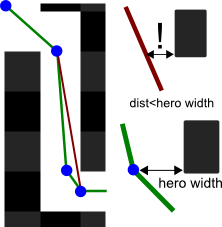As other option, you could split the path into straight parts. Then you only need to find the points where your original path leave a path part (no need to compute, just switch by direction of the next part). Only what remains it is connect points of your new smooth path!

EDIT: if you insist on the path you drawn, just compare the two extreme possibilities in which way path can leave a straight part (=point at one or the other end of the edge), and choose whatever produces shorter line segment (pythagoras theorem).
As for hero width, if you look closely - where is the path closest to edge? In the connection of last "tile" and the one before. Check path distance to the edge in that point(you will have to do math now, switch wont suffice), if it is less then hero width/2, add new point to the path at hero width/2 distance from edge.

Sorry of image inconsistency, already deleted source of original image.
